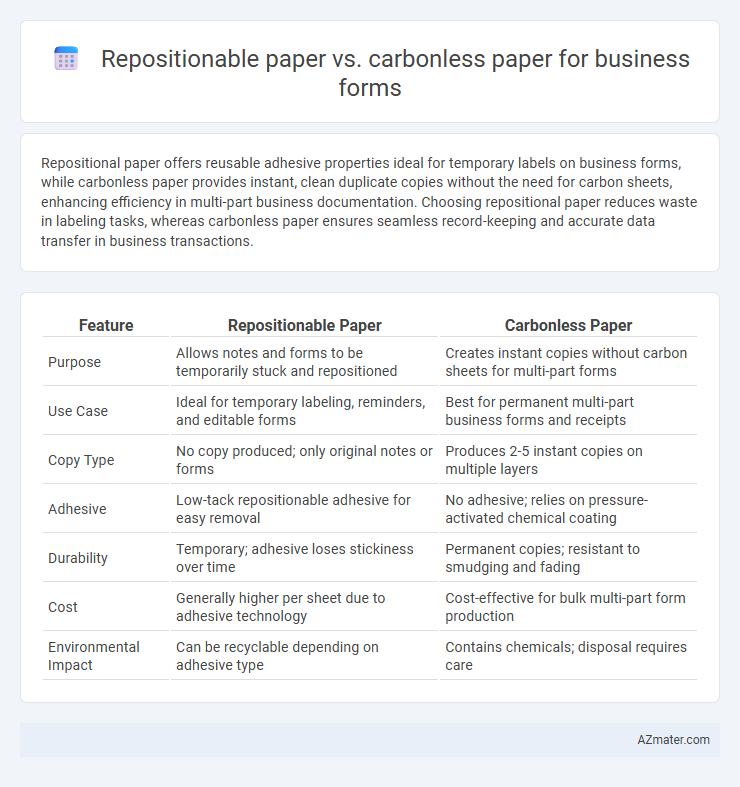Repositional paper offers reusable adhesive properties ideal for temporary labels on business forms, while carbonless paper provides instant, clean duplicate copies without the need for carbon sheets, enhancing efficiency in multi-part business documentation. Choosing repositional paper reduces waste in labeling tasks, whereas carbonless paper ensures seamless record-keeping and accurate data transfer in business transactions.
Table of Comparison
| Feature | Repositionable Paper | Carbonless Paper |
|---|---|---|
| Purpose | Allows notes and forms to be temporarily stuck and repositioned | Creates instant copies without carbon sheets for multi-part forms |
| Use Case | Ideal for temporary labeling, reminders, and editable forms | Best for permanent multi-part business forms and receipts |
| Copy Type | No copy produced; only original notes or forms | Produces 2-5 instant copies on multiple layers |
| Adhesive | Low-tack repositionable adhesive for easy removal | No adhesive; relies on pressure-activated chemical coating |
| Durability | Temporary; adhesive loses stickiness over time | Permanent copies; resistant to smudging and fading |
| Cost | Generally higher per sheet due to adhesive technology | Cost-effective for bulk multi-part form production |
| Environmental Impact | Can be recyclable depending on adhesive type | Contains chemicals; disposal requires care |
Introduction to Business Form Printing
Business form printing utilizes various paper types to enhance usability and efficiency, with repositional paper and carbonless paper being prominent options. Repositional paper allows temporary adhesion, enabling easy repositioning of forms without leaving residue, ideal for drafts and annotations. Carbonless paper facilitates instant duplicate creation without messy carbon sheets, streamlining data capture and record-keeping in business transactions.
What is Repositional Paper?
Repositional paper is a type of adhesive-backed paper designed to be easily removed and repositioned without leaving residue or damaging surfaces, making it ideal for temporary notes or business forms requiring frequent updates. Unlike carbonless paper, which transfers writing through pressure to create duplicates, repositional paper focuses on flexibility and reuse rather than duplicating content. This makes repositional paper particularly useful for dynamic business environments where forms, labels, or notes need to be adjusted or relocated regularly.
What is Carbonless Paper?
Carbonless paper, also known as NCR (No Carbon Required) paper, is designed to transfer writing from the top sheet to underlying sheets without using carbon paper or ink. It contains micro-encapsulated dye or ink that reacts with a clay or reactive coating on the sheet beneath to create a clear, instant duplicate. This technology is widely used in business forms for efficient multi-part document creation, eliminating the mess and hassle of traditional carbon papers.
Key Features of Repositional Paper
Repositional paper for business forms offers key features such as temporary adhesion that allows sheets to be easily lifted and repositioned without residue, enhancing convenience for editing and corrections. Unlike carbonless paper, which transfers writing through pressure to create duplicates instantly, repositional paper supports multiple rearrangements without losing stickiness or damaging the surface. This flexibility makes repositional paper ideal for workflows requiring frequent adjustments while maintaining clean and professional document presentation.
Key Features of Carbonless Paper
Carbonless paper eliminates the need for carbon sheets by using micro-encapsulated dye or ink that transfers content from the top sheet to underlying sheets, ensuring clear and instant duplicate copies. Its key features include smudge-resistant printing, compatibility with impact printers, and the ability to produce multiple copies simultaneously without any mess. This makes carbonless paper highly efficient and preferred for business forms requiring accurate and legible multi-part documents.
Benefits of Repositional Paper for Forms
Repositional paper offers the significant benefit of allowing users to easily lift and reposition forms without damaging the paper or leaving residue, enhancing flexibility during document handling. This type of paper improves workflow efficiency by enabling corrections or adjustments on business forms before finalizing, reducing waste and costs associated with errors. Compared to carbonless paper, repositional paper eliminates the need for carbon sheets or complex printing processes, making it ideal for businesses seeking eco-friendly and user-friendly form solutions.
Advantages of Carbonless Paper in Business
Carbonless paper offers significant advantages in business forms by eliminating the need for messy carbon sheets, ensuring cleaner and more efficient record-keeping. It provides instant duplicate and triplicate copies, enhancing productivity and reducing errors in transaction documentation. The ease of use and cost-effectiveness of carbonless paper make it a preferred choice for businesses aiming to streamline operations and maintain accurate records.
Comparing Cost: Repositional vs Carbonless Paper
Repositional paper typically incurs higher costs due to its adhesive properties and ability to be peeled and repositioned multiple times, making it ideal for temporary notes and labels in business forms. Carbonless paper, on the other hand, is generally more cost-effective for multi-part business forms as it eliminates the need for carbon sheets by transferring ink via micro-encapsulated dye, reducing material and cleanup expenses. Businesses choosing between repositional and carbonless paper should weigh initial material costs against functional benefits and usage frequency to optimize overall form management expenses.
Environmental Impact: Repositional vs Carbonless
Repositional paper generates less chemical waste compared to carbonless paper, which often contains phenolic compounds harmful to the environment. Carbonless paper's manufacturing process releases more pollutants and is less biodegradable, increasing landfill persistence. Businesses prioritizing eco-friendly solutions benefit from choosing repositional paper for reduced environmental impact.
Choosing the Right Paper for Your Business Forms
Selecting between repositional paper and carbonless paper for business forms depends on the need for flexibility versus permanence; repositional paper allows multiple uses of the same sheet with repositionable adhesive, ideal for temporary forms or drafts, while carbonless paper produces instant, lasting copies without the need for carbon sheets, essential for permanent transaction records. Repositional paper enhances efficiency in dynamic workflows where form contents frequently change, whereas carbonless paper ensures accurate and durable duplicate copies crucial for invoices, receipts, and contracts. Evaluate your business's documentation requirements, considering factors like copy durability, form reuse, and cost-effectiveness to choose the optimal paper type.

Infographic: Repositional paper vs Carbonless paper for Business Form
 azmater.com
azmater.com